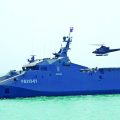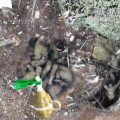
![]()
Intelligence Research Observatory
Feature Cover Image Courtesy of War on the Rocks
An Analysis Authored by an Esteemed Colleague Dr. C. Flaherty Independent Space Industry Analyst
Dr. Flaherty can be found on Twitter @ChrisFlaherty8
UKRAINIAN LAND DEEP BATTLE STRATEGY & TACTICS C.Flaherty
INTRODUCTION
This brief overview describes the Deep Battle Concept: this phrase has been used by commentators (based on public sourced information) to characterize various elements of the Ukrainian approach to battle. As well, this overview incorporates theory ideas about how a contemporary large-scale land battle, using historical models and precedents is fought between opponents. The function of this overview is to develop a set of modelling criteria, and concepts, in order to test, using wargaming, and modelling, how battles are currently fought, and will continue to evolve.
TWO FRONT WAR
A key problem facing the Russian invasion army they are likely fighting a Two Front War. The Ukrainian army figuratively is fighting a battle of 1000 punches:
‘Facing a larger more heavily armed opponent, the Ukrainian response has been a mass sustained series of small-scale attacks targeting and destroying Russian armoured vehicles, support infrastructure and causing casualties on every-side of the Russian military force, and throughout its body.’
TARGETING CIVILIANS
From the onset, the Russian basic strategy has been to target civilian centres. This has occurred in two contexts:
(1) Attacking cities, and infrastructure in order to control the campaign narrative, seeking to destroy civil stability, and dislocate the Ukrainian military’s capacity to keep fighting.
(2) Fighting a war front against the civilian population in Ukrainian occupied areas. Rather than come as liberators, the Russians clearly have adopted a terrorism campaign against remaining civilians, seeking to pre-empt any attempt at local resistance.
Russian warfare in occupied Ukraine, has been a pattern of murders, deportations, imprisonment, rape and torture. Local Russian occupation forces, have effectively been let-lose among the civilian population as means of repression, and crushing local resistance.
Ukrainian Countermove
The Ukrainian countermove to the Russian basic strategy targeting civilian centres, has depended on developing in the occupied territory, a second front, using unconventional forces, combining Special Forces: SF and Partisans implementing a campaign aimed at destroying the Russian army’s infrastructure supporting and sustaining its frontline. Part of the campaign has been a sub-set activity aimed at eliminating, and driving-back Russian artillery elements, and destroying the Russian attack architecture (discussed later in this overview).
Ukrainian defence has been successful turning Russian control of territory narrative against them –
‘The ongoing characterization of the Russo-Ukrainian war has been one of territory control, yet the Ukrainian defence has been fundamentally based on constant manoeuvre, and waging a Two Front War against the Russian occupation.’
The Ukrainian defence has been successful luring Russian forces (who believe they are in control of areas) to concentrate into islands within a wider battlespace, which has become saturated with Ukrainian SF and Partisans fighting a sustained campaign destroying Russian critical nodes. Called Interposing Tactics:
‘Interposition or interjection within a tactical situation describes the action or activity that interrupts a particular process. In the game of chess, for example, an interposing move would be one in which a player moves a piece between their king and the opponent’s piece which has placed the king in check.’
The chess example demonstrates a key feature of Interposing Tactics namely deployment of forces to block and cover Friendly from a Hostile. An extension of this idea would involve opposing forces dispersing or scattering freely over an Attack Surface to achieve the effect of blocking and covering all Friendlies from Hostiles. Interposing entities are then free to attack the Hostile; which effectively begins to breakdown the occupier’s hold on territory and isolate opponent forces. Ukrainian SF and Partisan campaigning against the Russian frontline infrastructure, may have contributed dramatically to the collapse of Russian resistance in the South, and likely have led to the current isolation of a substantial Russian force holding Kherson on the Right (West) Bank of the Lower Dnieper River.
At the same time Russian army fights a warfront in occupied territory, to their front they face a Ukrainian Concept of Battle, commonly called the Deep Battle.
DEEP BATTLE AND CONTEMPORARY BATTLE MODEL
Deep Battle Concepts, and Contemporary Battle Model, occur on a dynamic and disbursed battlefield as a series of concentric rings.
| ► Contemporary Battle Model has an Inner Ring: Proximity Battle Zone, and Outer Ring where other entities can be tied into the Proximity Battle from greater distances. Long-distance attacks can come from Land- and Sea-Based long-range heavy artillery, missile launches, marauding piloted aircraft and drones.
(1) The Proximity Battle Zone, is a central zone of concentrated force, where several units occupy an area, and are in direct contact with each other. Characterized by close-range fighting between similar forces: armour, foot, and depending on the size of the area, using local air mobility. |
(2) The Outer Ring is hundreds of kilometres: miles wide. Numerous fast manoeuvring fire power entities: heavy artillery, missile, rocket and drone launchers are used to interdict and destroy targets, in both the Proximity Battle Zone, and Outer Ring.
(3) Marauding Air Power comes from well outside the Outer Ring. Marauding Air Power can fly-over, or deliver attacks at greater distance interdicting and destroying targets.
(4) In the Ukrainian Deep Battle Concept, the opponent’s portions of the Inner and Outer Rings is saturated with attacking SF and Partisans.
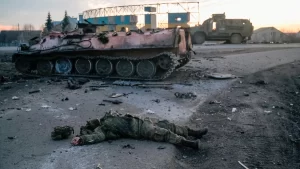
Photo Courtesy of Radio Free Europe
B.H.Liddell Hart’s Retiarius and Secutor Analogy
Ukrainian Deep Battle Concepts has its roots in a re-conception of B.H.Liddell Hart’s comparison identifying Napoleon’s campaigns against European armies to Retiarius (fisherman fighting with a weighted net and three-pointed trident) and Secutor (heavy armoured warrior) fights. The Hart-Napoleonic strategic net, used by the Retiarius, was formed by the division system trapping opponent forces through manoeuvre. Whereas, the Hart-Napoleonic tactical Retiarius trident was a combination:
(1) Skirmishers paving the way for an assault;
(2) Mobile field artillery concentrated against enemy weak spots; and,
(3) Rear-manoeuvre by forces moving and concentrating at the enemy’s rear, astride their communication lines.
Reimagining B.H.Liddell Hart’s comparison, we can visualize the Russian army as the Secutor, outmanoeuvred by the Ukrainian Retiarius using net and trident Deep Battle tactics. Figuratively, the Ukrainian net cast over their Russian opponent is composed of air and drone attacks, SF and Partisans, long-range precision artillery and missile strikes into Russian rear echelons in occupied territory, targeting command and control, communications, logistical elements, supply transporting and dumps. The Ukrainian tactical trident – used in the Proximity Battle, is a combination:
(1) Anti-vehicle weaponry;
(2) Effective Granulated Infantry Tactics and high-quality local-level leadership, initiative and self-organising small mobile units; and,
(3) Tank and other battlefield artillery fire power directed at immediate Russian forces.
| Recent Ukrainian tactical trident change has added highly manoeuvrable Light Divisions, able to rhizome-manoeuvre past Russian concentrations, pushing deep into occupied territory isolating (compelling occupiers to flee) and breaking up the occupation. |
Simultaneously, Ukrainian SF and Partisans have largely gained the upper hand destroying Russian military infrastructure, while Ukrainian artillery has massively evolved, increased its range and multiplied across the battlefield. Ukrainian Air Power has fundamentally changed across the battlefield as drones have dominated the sky above Russian occupation forces. While Russian airfields have been systematically knocked-out, and valuable aircraft destroyed on the ground, or withdrawn. A maritime dynamic has also changed. Russian dominance over Ukraine was fundamentally dependent on the Black Sea Fleet, for air warfare and missile bombardment. Its losses and withdrawal massively altered the land campaign picture.
In public perception, fundamental changes in Ukrainian military power, have been concealed by a mantra – Russia has enormous reserve forces. However, Russia’s post-2000 army was design for a short campaign against a ‘less than peer adversary’ (RAND, 2017), and is now fighting a peer adversary, against whom it lacks effective leadership, and is massively undertrained and equipped.
TARGETING PHILOSOPHY AND THINKING
Ukraine began the war in 2022 with various asymmetric disadvantages, such as facing an opponent with greater-than access to missile and artillery capacity. The disparity effected targeting and Maskirovka Practices (discussed later in this overview). Reacting to the disparity, has been widespread use of simple deception techniques, such as building wooden missile launchers intended to create a field of Low-Tech decoys, which potentially creates multiple threatening targets. The effect can be keeping the opponent off-balance as to where an actual attack will come from. The other object of the decoy is to play a ‘shell game’ with an attacker, creating a field of potential threats which can divert resources, and effectively paralyse opponent decision-making as to where, and what is the potential threat.
More than Decoy Defence, in the context of Maskirovka, there is also a targeting philosophy and thinking looking at how the target-end of the tactical equation can be exploited. In broad terms, a targeting system is only effective if it sees the target. Classical thinking on defence says target is hidden, decoyed, or blocked by an object. Normally defence strategy centres on the target itself, its manoeuvre and avoidance, hardening, exterior shielding, and ability to destroy the attacking object. However, defence strategy and tactics can also shift focus to the architecture around the attack itself. This is necessary, in dealing with weapons like hypersonic cruise missile that have: speed, manoeuvrable flight paths, enhanced targeting radars, and anti-jamming systems advantages which change defence strategies. The counterstrategy, is attacking the architecture used to get a missile from ‘A’ (launching platform) to ‘B’ (its target), by interrupting is targeting/guidance electronically, and depending on how it works, the Satellite-Based link guiding it towards its target.
Ukraine strategy focusing on the opponent’s attacking architecture is based on the Anticipatory Defence Model and Disruption Principle. The strategy is dependent on access to Space using Ally’s military intelligence satellites, and Private Third-Party Provider’s Earth survey satellites (discussed next); as well as guiding attacks to their targets using radar and directing ground forces, in particular SF, Partisans, and a network of patriots providing intelligence. A practical example of the Anticipatory Defence Model and Disruption Principle is attacking launching infrastructure. Such as the Ukrainian strategy destroying airfield infrastructure disrupting Russian air operations.
SPACE POWER CONCEPTS
The focus of this overview has been on Land Power Concepts. However, Space Power: SP issues are also significant in terms of understanding the Deep Battle Concept. A key concept, demonstrated by Ukraine in achieving SP, has been augmentation via Third-Party Providers in the Space Domain. Ukraine has likely achieved greater Space Domain Dominance over Russia, in two ways:
(1) Gaining support from Third-Party Earth Survey Providers who have enacted self-imposed Shutter-Control in regards to Ukrainian forces whereabouts, while putting into the public domain satellite pictures of Russian forces’ movement, location, composition and losses sites.
(2) Harnessing secure Third-Party Communications Providers such as Starlink. The use of Starlink also saw a Russo-SpaceX Space cyber battle play-out earlier in the year; in which SpaceX was victorious!
The Ukrainian strategic SP problem was having no capability, and being in a major dependency relationship with U.S., UK and EU Private Companies, and dependent on U.S.–NATO military support. The end goal currently is achieving the, “three pillars of Ukrainian Space Program” (Usov, 2022), by securing:
(1) Remote sensing services;
(2) Communications services;
(3) Autonomous capacity to bring this infrastructure into orbit.
Ukrainian SP currently lacks a viable, secure sovereign launch capability. The technology option, is likely to be solved with an air-launch capacity using a medium-range aircraft. Able to do emergency launches putting in orbit a constellation of micro satellites. Potential Ukrainian SP could also rely on recent exclusive access purchase of ICEYE SAR: Synthetic Aperture Radar satellites network capable of imaging locations at night, through clouds, fog and smoke, giving situational dominance over Attack Surfaces.
MOSQUITO FLEET STRATEGY APPLIED TO RIVER GEOGRAPHY
Ukraine lost more than 70 percent of its naval assets after Russia’s forcible annexation of Crimea. The remaining Ukrainian Black Sea Fleet was lost early in the 2022 invasion by Russia. Not unlike, Napoleon’s later fleet strategy after the Battle of Trafalgar (1805):
‘taking the remains of the sea fleet, and using it to create a seamen land force, and river flotilla in order to facilitate his continental land campaigns by dominating Europe’s river system.’
Opportunity remains for the Ukrainian Mosquito Fleet Strategy to be apply to river control as a means to take back occupied land. Ukrainian defence has a series of water-borne manoeuvre options which can be used to exploit a river geography dividing the country into successive sets of left and right banks. Rivers, and large water covered areas, including Ukraine’s system of dams strategically divide the country, and form a series of barriers which empty into the Black Sea.
The Ukrainian option currently has been to repurpose its sea fleet into a combat river flotilla on the Dnipro, as well as a Division conducting tasks in the north of the country near the Belarusian border. For instance, the key building blocks of the new force is eighteen boats, including two 35-foot riverine craft, six 40-foot maritime combat craft boats and ten 34-foot Dauntless Sea Ark patrol boats used to monitor and protect Ukraine’s rivers. River fleet activity – the ability to move by water, can allow forces to deeply penetrate into occupied areas placing an opposition, deep in the opponent’s rear echelons. Resources can be moved by river, including supplying SF and Partisans.
RELATIONSHIP TO POST-2000 RUSSIAN MILITARY TRANSFORMATION
Ukraine’s mode of battle has mirrored Russian, “emphasis on deception, electronic warfare, and strikes against command and communications … intended to disrupt adversaries and slow their ability to respond to developments on the battlefield.” (RAND, 2017)
Looking at the 2017 RAND analysis of the Post-2000 Russian Military Transformation, there is the Russian concept of a: “Disjointed Battle … [where] … forces … aim to disorient the adversary and prevent it from operating in its preferred fashion.” (RAND, 2017) We can also see examples of Disjointed Battle used by Ukrainian forces, such as luring Russian forces (who believe they are in control of areas) to concentrate into islands, becoming isolated and exposed to encirclement. The Ukrainian Deep Battle Concept apparently has relied on extensive SF insertion, and development of a Partisan campaign which has been effective destroying the Russian frontline’s infrastructure. This mirrors Russian battle concepts:
“that irregular forces will likely be present throughout the battlespace, providing information about adversary forces and potentially operating against high-value targets.” (RAND, 2017)
In a parallel development, Ukraine has consistently invested in SF and its Partisan movement in occupy territory, using attacks by these forces as prelude to a main attack; in much the same way in which Russia had envisaged using this type of warfare: ‘use of paramilitaries, Special Operation Force, unmarked units in the early stages of a conventional attack.’ (RAND, 2017)
Russia’s ability to take the war to Ukrainian cities, and civil infrastructure is made possible by the deployment of massive numbers of heavy long-range artillery: “Russian writings on the conduct of operations and tactical engagements emphasize the importance of the long-range fires contest.” (RAND, 2017) However, investment in latest U.S.-NATO long-range precision artillery for Ukraine has broadly outstripped Russia’s current capabilities. One of the most significant aspects of the Ukrainian defence has been its use of concealment. Strikingly, Ukrainian forces have proved more adept at,
“the practice of Maskirovka, which involves concealment of forces and intentions, as well as the use of decoys and deception to misdirect the adversary.” (RAND, 2017)
Ukrainian use of Maskirovka Practices likely relate to its better use of SP. Significantly, it appears there has been a near catastrophic failure of Russian SP in its inability to detect the build-up of Ukrainian forces, their positions and composition. There has also been an inability to block Starlink access, and to assert Satellite Shutter-Control over numerous Third-Party Providers, and conceal the whereabouts of their own forces.
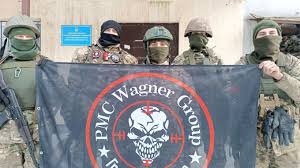
Image Courtesy of Moscow Times
NEXT EVOLUTION OF THE DEEP BATTLE
It is anticipated the next evolution of Ukrainian Deep Battle:
(1) Ukraine currently needs to rapidly double its tank force from 580 to 1,000+ vehicles to build armoured spearheads it needs for deep battle penetrations. At same time have capability to drive opponents away from tanks, and protect these weapons from attack. Gaining ability to muster traditional massed and supported tank spearheads, will allow Light Divisions to penetrate deep into occupied territory pursuing a Russian retreat.
(2) Development of Marauding Air Power is another key evolution which can play a critical role in evolving Deep Battle Concepts; however, this question I leave to the better informed!
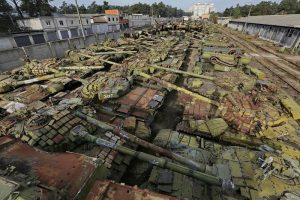
Image Ukraine Tank Yard-Courtesy of URBEX
SOME COMMENTS ON RUSSIAN PARTIAL MOBILIZATION
The Russian countermove to Ukrainian success expelling their forces has been to raise a new force around 300,000 reservists for the war in Ukraine using a Partial Mobilization. Driven by Russian military traditionalists criticisms of the current Russian army, namely: ‘it fails to have any offensive, defensive, or resistance tactical power being too weak, and small numbered.’ Currently a Russian Battalion Tactical Group has ten tanks, and 200 infantry. The lack of concentrated tank formations, and infantry support, has for the Russian military traditionalists, wanted to be replaced returning to Soviet-styled massed tank (500-1,000 vehicles) in spearheads, and infantry assaults using 1,000 soldiers or more in support. Significantly, massive loss of armoured fighting vehicles so far in Ukraine, would create a situation where most of these assault troops will need to attack on foot – likely rushed to the front with only provisional training and equipping, seeking a massive break-out attack. Given, the newly formed 3rd Army Corps, after joining Russian forces in Kharkiv Oblast retreated abandoning much of its weapons, to advancing Ukrainian forces in the South recently – it is open to question will newly mobilized forces act any differently.
Russia and Ukraine are now moving into its winter season, and the question is how well equipped and prepared will Russian, compared to Ukrainian, forces be for extreme cold fighting conditions? Answering this question, we need to consider the ‘Model of the Current Russo-Ukraine War Evolution’ where over time, Ukrainian forces are on an Up-Tech progression, as capabilities expand, and increase in capacity with higher-level technology and tactical evolution; whereas Russian forces are on Low-Tech regression: a deep-dive with reducing capability, and return to older less Technology-Based warfare concepts.
REFERENCES
- Boston, S. Massicot, D. 2017 The Russian Way of Warfare: A Primer. RAND.
- Usov, V. 2022 Volodomyr Usov & David Hamilton. Space & the Russian Invasion of Ukraine. Space Innovation Summit. YouTube Interview. America’s Future Series (23 July).

![]()
Intelligence Research Observatory


